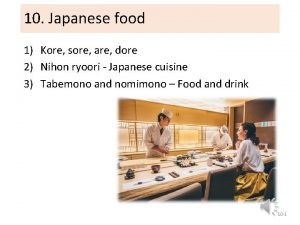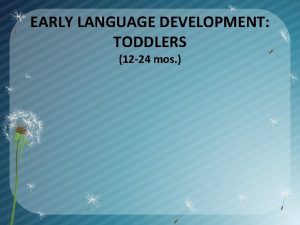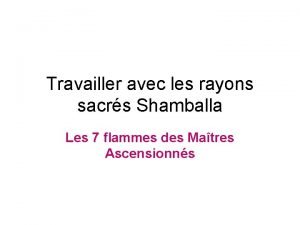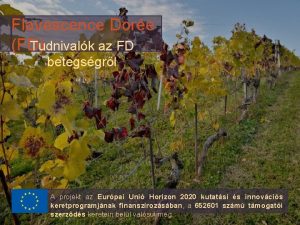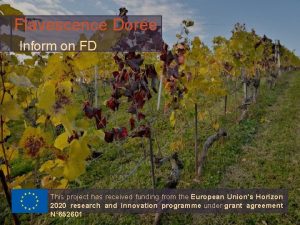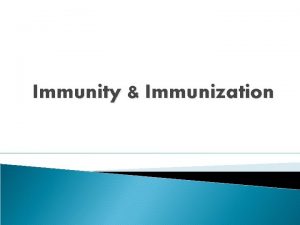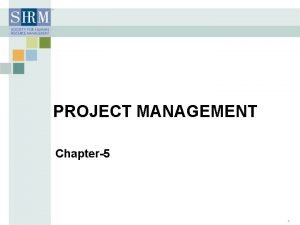Flavescence Dore Specific management of FD This project



































- Slides: 35

Flavescence Dorée Specific management of FD This project has received funding from the European Union's Horizon 2020 research and innovation programme under grant agreement N° 652601

Flavescence Dorée What is it? Flavescence dorèe is a disease widely spread caused by a phytoplasma, a microorganism that lives inside of the plant, usually it does not kill the vine but it does obstruct the lymph path and alters the plant metabolism.

Flavescence Dorée What is it? The FD phytoplasma is transmitted plant to plant by an insect, schapoideus titanus, that feeds on the vine’s lymph; once a plant gets infected it can never heal.

Flavescence Dorée Video-clip

Flavescence Dorée How to manage FD Having in mind that ST has just one generation per year, and that the Phytoplasma is not passed down to the next ST generations

Flavescence Dorée How to manage FD Is possible to manage Flavescence Dorée only if those 4 practices are adopted: • The new plants do not have to be infected • The fight against the vector insect • Prospection activities • Uprooting infected plants

Flavescence Dorée Vine plantation The new plants do not have to be infected. Since the FD phytoplasma is heat-sensitive the nurseries are starting to make an hot water treatment on the new plants. This treatment guarantees non infected plants.

Flavescence Dorée Fight against the vector The fight against the vector insect Scaphoideus titanus is key to a successful FD management.

Flavescence Dorée Video-clip

Flavescence Dorée Fight against the vector In order to be successful with the insecticide treatment is important to monitor the insect population, the most common ways are: • Emerging cages • Modelling • Monitoring of nymphal development stages • Monitoring adult with traps

Flavescence Dorée Emerging cages These cages are a very effective tool to determine hatching when appears. Scaphoideus Two years titanus old first wood, preferred for egg laying, from a plot where Scaphoideus titanus presence was detected in the previous year are kept in a cage and hatching moment is monitored every day.

Flavescence Dorée Emerging cages A sticky trap is put inside the cage in order to capture nymphs as soon as they hatch. When date of first hatching is determined the effective date for first insecticides treatment is positioned one month later.

Flavescence Dorée Modelling Decision support systems exists and are able to predict in vineyard pests and diseases, including Scaphoideus titanus. One model currently in development can predict when each stage of Scaphoideus titanus nymphs will appear according to specific climatic conditions.

Flavescence Dorée Modelling Model is based on observations made the years before and historical and daily temperatures. In order to provide a more accurate possible real observation data on stages need to be informed.

Flavescence Dorée Monitoring adult with traps Yellow sticky traps can be set up in vine-plot and can be monitored by growers themselves if properly instructed, or by specialists. Traps will help to decide when apply adulticide treatment. Adult flights have been often observed from the beginning of July to later than expected (October).

Flavescence Dorée Monitoring adult with traps The late control of vector leafhopper population is important to decide the opportunity of an additional insecticide against adults.

Flavescence Dorée Fight against the vector According to the region and to the population of ST, different treatment strategies could be adopted: • 2 Treatment strategy • 3 treatment strategy • 4 treatment strategy

Flavescence Dorée Fight against the vector Two treatments strategy: This strategy is adopted when the presence of ST and of the infected plants are low. The 1 st treatment is made 1 month after hatching The 2 nd is done on the adult population.

Flavescence Dorée Fight against the vector Three treatments strategy: This is a strategy used in moderately infected vineyard The 1 st treatment is done month after hatching The 2 nd at the end of the remanence of the 1 st treatment (or on the adults) The 3 rd on the adults

Flavescence Dorée Fight against the vector Four treatment strategy: This strategy is adopted in highly infected vineyards 1 st treatment is done before flowering 2 nd on the nymphs 3 rd at the end of the previous treatment remanence 4 th on the adults

Flavescence Dorée Fight against the vector Without any treatment Scaphoideus titanus population could increase individuals per hectare up to 10. 000

Flavescence Dorée Monitoring the vineyard If ST feeds on an infected wine it becomes infective, for this reason monitoring the vineyard in order to scout infected plants is key to success for managing FD.

Flavescence Dorée Monitoring the vineyard The monitoring has to be done at least at individual vineyard scale; but monitoring at communal scale gives better results.

Flavescence Dorée Uprooting infected plants Once an infected plant has been scouted it has to be uprooted in order to stop disease spreading.

Flavescence Dorée Uprooting infected plants Uprooting or destruction of infected grapevines is suggested and mandatory in most of regions by national decree

Flavescence Dorée Uprooting infected plants During period of leafhopper presence (from May to August) as soon as an infected vine is detected it must be uprooted. The sooner an infected vine is uprooted, the better it is

Flavescence Dorée Uprooting infected plants If Scaphoideus titanus can’t feed on the infected vine, it won’t become infectious and won’t participate to disease’s propagation.

Flavescence Dorée Uprooting infected plants LEAVING INFECTED GRAPEVINES IN THE PLOT WILL INCREASE CONSIDERABLY INFECTION LEVEL IN THE COMING YEARS!

Flavescence Dorée Wild vines management Wild vines has both the Phytoplasma and the vector insect, though if a wild vine is infected it will not show symptoms. For this reason is important both to fight the vector and to uproot the wild vines.

Flavescence Dorée Wild vines management The adults are the form that moves the most (up to more than 1 km), so is important not to manage the wild vines from May to October, because ST might migrate in a cultivated vineyard.

Flavescence Dorée Wild vines management IF SCAPHOIDEUS TITANUS CAN’T FEED ON THE INFECTED VINE, IT WON’T BECOME INFECTIOUS AND WON’T PARTICIPATE TO DISEASE’S PROPAGATION.

Flavescence Dorée Quiz Please answer to the given questions

Flavescence Dorée Quiz

Flavescence Dorée Quiz Results and Discussion

Flavescence Dorée CREDITS Vivai Fratelli Nicola Ana Chiavari Daniele Eberle Agroscope Viten Andrea Lucchi Chambre de’agriculture Bouches-du-Rhone
 Introduction for project
Introduction for project Poornima dore
Poornima dore Kate madox
Kate madox Delta dore ems
Delta dore ems Kore sore are dore
Kore sore are dore La chute de lucifer gustave doré
La chute de lucifer gustave doré Delta dore ems
Delta dore ems Andromeda dore
Andromeda dore Iso delta dore
Iso delta dore Prade haute mont dore
Prade haute mont dore Dore's primitive speech acts chart
Dore's primitive speech acts chart Rayon rubis doré
Rayon rubis doré Over land by rail’, gustave dore, 1870
Over land by rail’, gustave dore, 1870 Kore sore are dore
Kore sore are dore Dore neighbourhood plan
Dore neighbourhood plan Bellhouse dore
Bellhouse dore Specific gravity units g/ml
Specific gravity units g/ml Specific volume
Specific volume The role of project management in achieving project success
The role of project management in achieving project success Iteration workflows in software project management
Iteration workflows in software project management How to reduce project duration
How to reduce project duration Modern project management began with what project
Modern project management began with what project What is strategic assessment in software project management
What is strategic assessment in software project management When conducting post project audits
When conducting post project audits Microsoft project agile
Microsoft project agile Type n terminations
Type n terminations Asset management vs project management
Asset management vs project management Configuration management project management
Configuration management project management Basic principles of cost management in project management
Basic principles of cost management in project management Project configuration management
Project configuration management Project integration management processes
Project integration management processes Top management and middle management
Top management and middle management Top management middle management first line management
Top management middle management first line management Top level management
Top level management Background of the project example
Background of the project example Process indicators enable software project manager to
Process indicators enable software project manager to




